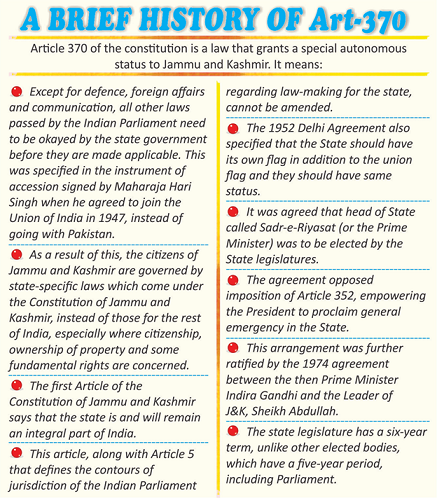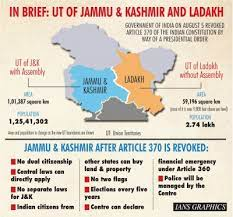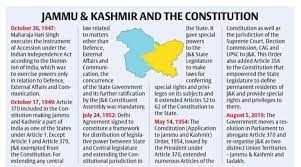What is the debate around Article 370?
Relevance:
GS Paper – 2, Indian Constitution, Centre-State Relations.
Why in news?
The ongoing arguments before a Constitution Bench of the Supreme Court on the abrogation of Jammu and Kashmir’s special status under Article 370 throw considerable light on the history behind the unique status enjoyed by the State until August 2019, when the Centre removed it.
Why was J&K given special status?
- Jammu and Kashmir was accorded special status because of the circumstances in which it acceded to India soon after Independence. Sandwiched between the two new Dominions of India and Pakistan, the State did not make an immediate decision on which country to join, as it had vital economic and cultural links with both.
- However, by October 1947, Maharaja Hari Singh was faced with regular military attacks from the Pakistan side by “soldiers in plainclothes, desperadoes with modern weapons”.
- There was mass infiltration by heavily armed tribesmen from the North-West Frontier into Kashmir, and the Maharaja felt this could not happen without the support of the governments of Pakistan and of the North-West Frontier Province.
- In a desperate letter to India’s Governor-General, Lord Mountbatten, on October 26, 1947, he sought help from India, noting that “naturally they cannot send the help asked for” without his State acceding to the Dominion of India.
- Therefore, he attached an ‘Instrument of Accession’ with the letter. However, it was not unconditional. He specified matters on which the Dominion legislature may make laws for Jammu and Kashmir, but the rest of the powers were to be retained by the State.
- These subjects were Defence, Foreign Affairs and Communications.
Was the accession temporary?
- While India was then ruled under the provisions of the Government of India Act, 1935, Jammu and Kashmir had its own Constitution since 1939. In the Instrument of Accession, Hari Singh had laid down a condition that it cannot be altered unless he accepted the change.
- Quite significantly, he said: “Nothing in this Instrument shall be deemed to commit in any way to acceptance of any future Constitution of India or to fetter my discretion to enter into arrangement with the Government of India under any such future Constitution.”
- When Article 370 was adopted in the Constituent Assembly of India, care was taken to see that it reflected the clauses and spirit of the Instrument of Accession.
- Hence, the key issue of whether the status could have been abrogated unilaterally is being argued in historical terms, and not merely in legal terms.
What are the features of Article 370?
- Many believe that Article 370 is the sole mechanism by which Jammu and Kashmir can be a part of India, and that without it, the conditions of its accession will be breached. It falls under a heading ‘Temporary provisions with respect to the State of Jammu and Kashmir’.
It has three core principles:
- (a) On items in the Union List and Concurrent List, the power of Parliament to make laws for the State will be limited to those matters that correspond to those specified in the Instrument of Accession; and, even that will be in ‘consultation’ with the State government.
- (b) On other matters in these Lists, Parliament can make laws for the State only with the State government’s ‘concurrence’. This is why until before the abrogation, Indian laws did not automatically apply to Jammu and Kashmir.
- (c) Article 1 (which declares India a Union of States) and Article 370 itself were made applicable as such to J&K. However, the rest of the Constitution of India would be applicable only through Orders passed by the President from time to time “with exceptions and modifications”.
- Finally, the Article provided for its own demise: the President could declare it inoperative if there is such a recommendation from the State Constituent Assembly.
How was the special status removed?
- On August 5, 2019, President Ram Nath Kovind initially issued an Order “with the concurrence of the State government of Jammu and Kashmir”.
- As the State was then under President’s Rule, it is presumed that the State Governor gave such concurrence.
- The Order stated that all the provisions of the Constitution of India, as amended from time to time, will be applicable to Jammu and Kashmir. It superseded the Constitution (Application to Jammu and Kashmir) Order, 1954, and the amendments made to it in subsequent years.
- However, further measures were required. The President’s August 5 Order made crucial changes to definitions in Article 370. For this, it added provisions to Article 367 of the Constitution which describes how to interpret some terms.
- The new clause said, when applicable to Jammu and Kashmir, all references to the ‘Sadar-i-Riyasat’, acting on the aid and advice of the Council of Ministers, would be construed as references to the Governor of Jammu and Kashmir.
- All references to the State government shall mean “the Governor”. And most importantly, the reference to the “Constituent Assembly” in a proviso to Article 370 (3) was amended to read “Legislative Assembly of the State”.
- A resolution was introduced to elicit Parliament’s views (instead of the J&K Assembly because the State was under President’s Rule) on the introduction of a new law to reorganize Jammu and Kashmir as two new Union Territories – ‘Jammu and Kashmir, as a Territory with an Assembly, and Ladakh as a Territory without an Assembly.’
- Another resolution was adopted in Parliament to recommend that Article 370 be declared inoperative. Parliament was acting on behalf of the J&K Legislative Assembly, which itself was treated as the equivalent of the State’s Constituent Assembly.
- The President issued another order on August 6 declaring Article 370 inoperative except for a clause that declared that all provisions of the Constitution will apply to J&K.
What are the legal issues involved?
- The key questions so far argued on behalf of petitioners who have challenged the removal of the special status and downgrading and bifurcation of the State are: whether the status of J&K had not become permanent after the Constituent Assembly refrained from any decision on Article 370; whether the latter effectively prevents the Union government from unilaterally altering the State’s relationship with India, and whether what was considered a ‘temporary’ provision prior to the work of the State’s Constituent Assembly had not become permanent subsequently.
- The Bench has raised questions whether the dissolution of the State Constituent Assembly could render Article 370 beyond abrogation or amendment, as if it is part of the Basic Structure, and whether the State’s accession had not become complete after the terms of its relationship with India had been finalized by the respective Constitutions. And why Parliament could not alter its status in exercise of its sovereign power through legal and constitutional means.
Source: The Hindu






